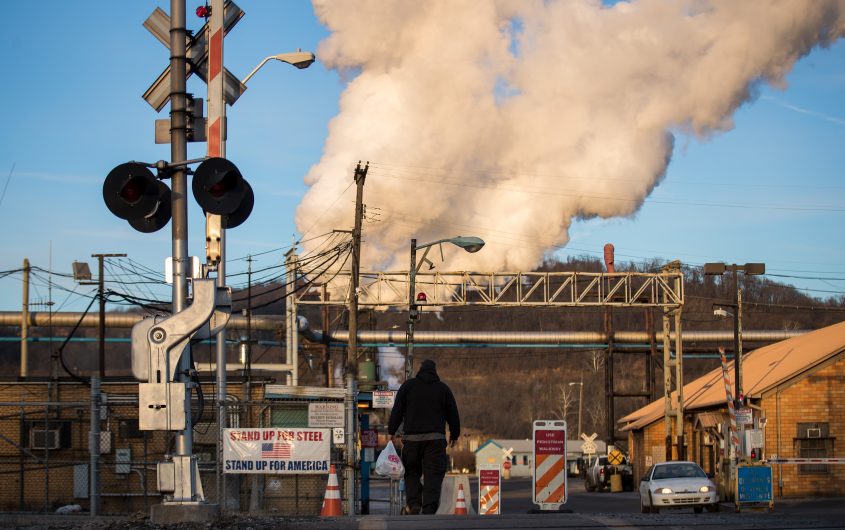
Drew Angerer/Getty Images
Trump’s Tariff Policy Present – and Yet-to-Come

Peter S. Rashish
Vice President; Director, Geoeconomics Program
Peter S. Rashish, who counts over 30 years of experience counseling corporations, think tanks, foundations, and international organizations on transatlantic trade and economic strategy, is Vice President and Director of the Geoeconomics Program at AICGS. He also writes The Wider Atlantic blog.
Mr. Rashish has served as Vice President for Europe and Eurasia at the U.S. Chamber of Commerce, where he spearheaded the Chamber’s advocacy ahead of the launch of the Transatlantic Trade and Investment Partnership. Previously, Mr. Rashish was a Senior Advisor for Europe at McLarty Associates, Executive Vice President of the European Institute, and a staff member and consultant at the International Energy Agency, the World Bank, UN Trade and Development, the Atlantic Council, the Bertelsmann Foundation, and the German Marshall Fund.
Mr. Rashish has testified before the House Financial Services Subcommittee on International Monetary Policy and Trade and the House Foreign Affairs Subcommittee on Europe and Eurasia and has advised three U.S. presidential campaigns. He has been a featured speaker at the Munich Security Conference, the Aspen Ideas Festival, and the European Forum Alpbach and is a member of the Board of Directors of the Jean Monnet Institute in Paris and a Senior Advisor to the European Policy Centre in Brussels. His commentaries have been published in The New York Times, the Financial Times, The Wall Street Journal, Foreign Policy, and The National Interest, and he has appeared on PBS, CNBC, CNN, NPR, and the BBC.
He earned a BA from Harvard College and an MPhil in international relations from Oxford University. He speaks French, German, Italian, and Spanish.
Trump Rescinds Steel, Aluminum Tariffs Amid Concerns for Auto, Construction Industries
Washington, December 20, 2019 – Stating that he wanted to avoid “too much of a good thing” for the U.S. economy, President Trump today decided to lift the 25 percent tariffs on steel and the 10 percent tariffs on aluminum that his administration put in place in March 2018. The trade restrictions had been authorized under section 232 of the 1962 trade law that allows the U.S. to limit trade based on national security concerns.
The move follows the publication of a report by the International Trade Commission showing that the tariffs failed to boost employment in the steel industry and led to an overall decline in U.S. GDP.
Pressure to remove the tariffs had been mounting for several months, with the U.S. automobile and construction industries—heavy users of both domestic and imported steel—voicing increasing concern about the impact of the tariffs. There have been reports that both domestic and foreign car producers in the U.S. were considering moving their plants abroad in order to access lower-priced steel.
The White House is thought to be particularly concerned that the tariffs did not produce the expected jump in job creation in the domestic steel industry. While some U.S. producers did post initial gains, the increased revenues did not translate into more hiring in the sector. Instead, companies used the additional profits to invest in industrial robots and other forms of automation.
Politics are thought to have played an important role in the White House’s decision. As President Trump ramps up his reelection campaign, there is concern among his advisors that polls in traditional industrial states like Michigan and Ohio that were key to his 2016 victory are not demonstrating the “steel bump” that had been predicted. Instead, rising unemployment in other parts of the manufacturing base have sent many voters into the undecided column.
Another factor in the course reversal appears to be the administration’s stepped-up focus on China. While the White House did impose restrictions on Chinese companies last year as part of its Section 301 investigation into the country’s intellectual property practices, the effects of these actions have been modest. There is an increasing realization in Washington that without cooperation from key allies like the European Union and Japan, progress will be limited.
As one senior White House official told reporters today, “the President has said on more than one occasion that America First does not mean America alone. We are going to work hand in hand with our European and Japanese friends to advance our objective of opening up the Chinese economy.” While Brussels and Tokyo showed restraint following the imposition of the steel and aluminum tariffs, from which they won partial exemptions, they have been cautious about lining up with Washington on a cooperative agenda while the tariffs were in place.
The NAFTA renegotiations, which are viewed as being near completion, also are likely to have played a role in the administration’s decision on the steel and aluminum tariffs. While initially skeptical, the Trump administration has become more favorable to staying in NAFTA since the demonstrations in Washington late last year by U.S. farmers demanding that their export markets in Mexico and Canada remain open.
The White House wants the NAFTA negotiations wrapped up before the president heads into the home stretch of the election campaign. But Canadian and Mexican negotiators are reported to be slow-walking the talks until the administration pledges to restrict the use of 232 in the updated NAFTA agreement. Dropping the tariffs sends the kind of signal that Ottawa and Mexico City are thought to need in order to rally public support to conclude the talks.







